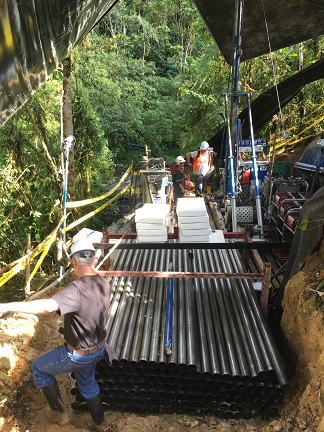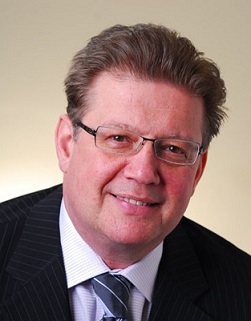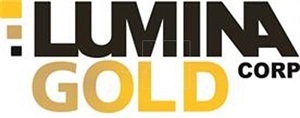The Lumina group, led by Marshall Koval as president and CEO, and Leo Hathaway as SVP, has successfully advanced and sold five resource companies and one royalty company for proceeds totalling some US$1.5 billion, including Lumina Copper and its Taca Taca project in Argentina to First Quantum Minerals (CN:FM), Global Copper and its Relincho project in Chile to Teck Resource (US:TECK), Northern Peru Copper and its Galeno project in Peru to China Minmetals/Jiangxi Copper, and Regalito Copper and its Caserones project in Chile to Pan Pacific Copper and Mitsui. The Lumina group of companies has the continuing support of mining entrepreneur Ross Beaty as the leading shareholder.
Lumina currently has the second-largest land package in Ecuador, a country that is significantly under-explored compared to its South American peers, and has an equally large potential for gold and copper discoveries. Where some investors see country risk, Lumina sees opportunity. “With the easing of mining restrictions and desire for outside investment, we saw Ecuador as a unique opportunity in what is a relatively under-explored county that was analogous to, for example, Peru in the early 1990s,” says Koval.
Lumina Gold was created from the merger of Ecuador Gold and Copper with Odin Mining and Exploration in 2016, although the Lumina group acquired an 80% interest in Odin Mining in early 2014. The merger brought together two advanced-stage exploration projects: Cangrejos in El Oro province and Condor in Zamora-Chinchipe province, which together host approximately 15 million ounces of gold and substantial copper resources. Management expects that continued drilling throughout 2017 and 2018 will grow and upgrade the existing resources.
Whilst Ecuador has considerable copper potential, this new venture marks a departure from the group’s previous base metal successes, as Lumina’s primary focus is gold.
The Lumina group knows how to execute and rapidly advance projects. Over the past 12 months, the company declared a 4Moz maiden inferred gold resource at the Cangrejos deposit, whilst actively engaging in the acquisition of other opportunities through the purchase of Ecuador Gold and Copper in November 2016 to obtain the Condor project and add significant exploration concessions.
With management’s experience in creating and realising value, the next 12 months should be active. A revised resource at Cangrejos to upgrade inferred resources to indicated is expected by year-end. The new resource will look to enhance both the scale and grade of the project. A preliminary economic assessment at Cangrejos will follow in the second quarter of 2018. In addition, drilling at the Santa Barbara deposit within the Condor project will commence by year-end.
Cangrejos currently has an inferred resource of 191.8 million tonnes grading 0.64g/t Au, 0.8g/t Ag and 0.1% Cu at a 0.35g/t AuEq cut-off with infill and step-out drilling underway to upgrade the resource. Recent infill drilling results from the 12,000m programme include up to 305m grading 1.90g/t Au and 0.30% Cu.
Future growth following the initial PEA is represented by the Gran Bestia area 1km away that has received minimal drilling to date. “There is the opportunity for a satellite deposit at Gran Bestia that could enhance the future economics of Cangrejos,” says VP corporate development Scott Hicks.

Condor, also in the south of the country, hosts a mix of porphyry and epithermal deposits. Santa Barbara, the largest deposit at Condor, hosts 6Moz of gold in the indicated category with 364.6Mt grading 0.5g/t Au, 0.9g/t Ag and 0.1% Cu as well an additional 2.3Moz of gold in inferred. Condor as a whole hosts about 11Moz of gold, with numerous potential areas for growth. Drilling at Santa Barbara later this year will try to expand the deposit to the east, which was previously undrilled.
And with Ecuador awarding new exploration concessions again following a multi-year moratorium, the company has been quick to move, building on the local knowledge and experience of the in-country team led by SVP Diego Benalcazar, to build its exploration land position by being an active participant in the most recent concession auctions. The company was awarded substantial concessions between November 2016 and April 2017.
“The concessions Lumina has added since November have made it the second largest concession holder in Ecuador and one of the leading gold explorers in the region. Our technical team of geologists has already commenced work across this portfolio of highly prospective concessions,” said Benalcazar in April.
Year to date exploration work has shown separate large multi-kilometre gold, copper and molybdenum anomalies. Company geologists are defining drill targets within three of the most prospective areas on the new concessions, being the Orquideas, Cascas and Pegasus A areas.
“The 2017 field work programme to date has defined exciting areas on three of the new concessions as well as substantial additional soil anomalies at Condor,” said Benalcazar.
Since Lumina’s primary focus is gold, it may look to divest primary copper targets that it identifies.
With US$6.5 million in the bank as of June, Lumina is continuing to progress its work programmes. The company spent $6M over the first six months of the year and its last raise was C$20 million in November 2016.
Ecuador is beginning to rebuild its reputation as a mining jurisdiction and is winning back investors that retreated in 2009 after a government mandate introduced challenging adjustments to the taxation and structure of the sector. Lumina moved quickly to be one of the first companies to take advantage of the improving investment environment in Ecuador to seek the value creation that emerging jurisdictions can provide.
Well-managed mining sector stimulation by mining minister Javier Cordova, exploration success by other juniors such as Solgold (LN:SOLG) and development advances such as Lundin Mining’s (CN:LUG) Fruta del Norte are helping bring the country to the forefront. That said, Lumina is currently one of the cheapest stocks in Ecuador on a per ounce basis.

“We would like to think this will be analogous to Lumina Copper: take unloved early stage assets with drilling or a resource, expand the resource, advance and de-risk the projects and then monetize the assets in a higher commodity price environment,” says Scott Hicks.
Lumina Gold – at a glanceHEAD OFFICE: 410 - 625 Howe St, Vancouver, British Columbia, Canada V6C 2T6
Telephone: +1 604 646 1890 Email: info@luminagold.com Web: www.luminagold.com/contact DIRECTORS: Marshall Koval, Lyle Braaten, Heye Daun, Donald Shumka, Michael Steinmann, Stephen Stow. QUOTED SHARES ON ISSUE: 231.8 million MARKET CAP (at September 4th, 2017): C$155.3 million MAJOR SHAREHOLDERS: Insiders/management (12.7%), Ross Beaty 1(4.4%)
|


























